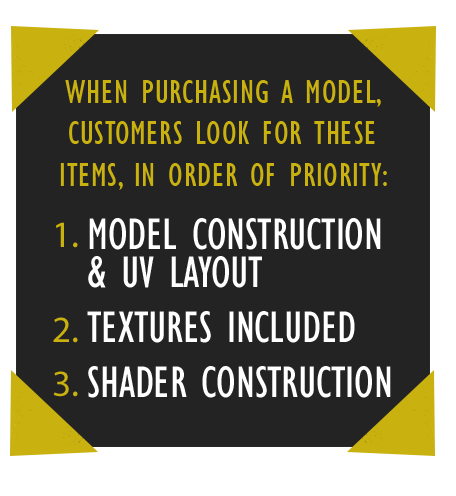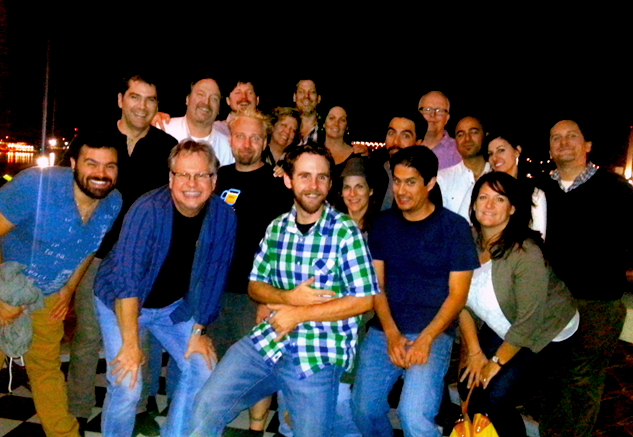This year’s CheckMate Advisory Board Meeting was a rousing success! While we made sure to feed and entertain everyone while they were in New Orleans, 3D Modeling was, as usual, at the forefront of everyone’s minds. We also got to add a number of new board members, representing IKEA, Armstrong & White, as well as welcoming Michele Bousquet back in an Advisory Board role, given her track record with CheckMate. There were many roundtable discussions over the two-day, on-site meeting, and what the Advisory Board had to say about using TurboSquid models was surprising, even to us.
Over the next few months, we’ll be posting more specific information gathered from the meetings, but for now, we feel it’s important to give our dedicated artist community a quick recap on several major topics.
This is information that comes directly from the folks who are buying and using your 3D model content daily, and the insights they provided covered a broad range of industries and needs, from film and television, to architectural design, game development, advertising, news, and furniture manufacturing. Since you’re making models to sell on the site, we feel this kind of feedback is timely and worth reading.


![]() Several Advisory Board member companies now rely more heavily on CheckMate models and won’t allow a non-CheckMate file to be purchased if there is a CheckMate one available. Why? Because they know with a CheckMate model, they “can run with it,” without being concerned over quality or usefulness when it comes to further changes or modifications, regardless of their pipeline.
Several Advisory Board member companies now rely more heavily on CheckMate models and won’t allow a non-CheckMate file to be purchased if there is a CheckMate one available. Why? Because they know with a CheckMate model, they “can run with it,” without being concerned over quality or usefulness when it comes to further changes or modifications, regardless of their pipeline.
![]() Lower resolution or un-subdivideable content is becoming less useful as directors and clients constantly change their minds and want to see scenes from all angles… meaning background objects can unexpectedly and quickly become foreground objects.
Lower resolution or un-subdivideable content is becoming less useful as directors and clients constantly change their minds and want to see scenes from all angles… meaning background objects can unexpectedly and quickly become foreground objects.
![]() Realistic models are strongly preferred. While clients know that your creativity is a great thing and provides huge benefits within your work, a real-world modeling pipeline requires models that look exactly like the thing they represent. In short, if you’re modeling a product that exists physically, you should be using a ton of references, so you can model it exactly the way it was designed. The Board wants artists to know that they can be as creative as they like in getting to the digital double of the real-world object, not in taking liberties with the way the object looks.
Realistic models are strongly preferred. While clients know that your creativity is a great thing and provides huge benefits within your work, a real-world modeling pipeline requires models that look exactly like the thing they represent. In short, if you’re modeling a product that exists physically, you should be using a ton of references, so you can model it exactly the way it was designed. The Board wants artists to know that they can be as creative as they like in getting to the digital double of the real-world object, not in taking liberties with the way the object looks.

![]() Today’s production pipelines are no longer based around a single 3D app and are far more “fractured” in terms of where specific aspects of the production takes place, with content flowing in and through multiple platforms. Whether you’re modeling in Modo, Maya, Mudbox or ZBrush, texturing in BodyPaint3D, Mari, Photoshop or GIMP, the content a company makes or purchases is being pushed into multiple tools downstream as part of production.
Today’s production pipelines are no longer based around a single 3D app and are far more “fractured” in terms of where specific aspects of the production takes place, with content flowing in and through multiple platforms. Whether you’re modeling in Modo, Maya, Mudbox or ZBrush, texturing in BodyPaint3D, Mari, Photoshop or GIMP, the content a company makes or purchases is being pushed into multiple tools downstream as part of production.
How does that affect you as a TurboSquid artist? It means these companies are looking for a consistent standard like CheckMate that ensures clean transport between products, and that if you’re not building to the standard yet, you should look at it again.

![]() When looking at TurboSquid models, the Advisory Board mentioned that it can be a challenge to do a good comparison of materials and shaders between models, since lighting can be dramatically different. As such, they suggested that we look at building HDRI/EXR only standard light-rigs that could be used across renderers and 3D apps, so that there could be a better way to determine how a model’s materials are constructed and how they react to a consistent and known lighting environment. This is how most of the Advisory Board members review their own internal models, so we’re looking at how this might be achieved within the TurboSquid artist community. We’ll keep everyone posted on our progress here.
When looking at TurboSquid models, the Advisory Board mentioned that it can be a challenge to do a good comparison of materials and shaders between models, since lighting can be dramatically different. As such, they suggested that we look at building HDRI/EXR only standard light-rigs that could be used across renderers and 3D apps, so that there could be a better way to determine how a model’s materials are constructed and how they react to a consistent and known lighting environment. This is how most of the Advisory Board members review their own internal models, so we’re looking at how this might be achieved within the TurboSquid artist community. We’ll keep everyone posted on our progress here.

As we’re growing our CheckMate certification, we’re looking to grow with our artists, and help them to achieve an even higher standard.
![]() Artist training is an ongoing challenge for all companies as tools, techniques, and pipelines change annually. Our Advisory Board told us that artists who can’t evolve and adapt to new technologies and processes tend to find themselves quickly out of a job in production as the demands change. Specifically as it relates to modeling, they mentioned that having a solid foundation of modeling skills and techniques is the most important thing any artist can bring to the job, since new hires are not necessarily working inside of the 3D app that they originally started in.
Artist training is an ongoing challenge for all companies as tools, techniques, and pipelines change annually. Our Advisory Board told us that artists who can’t evolve and adapt to new technologies and processes tend to find themselves quickly out of a job in production as the demands change. Specifically as it relates to modeling, they mentioned that having a solid foundation of modeling skills and techniques is the most important thing any artist can bring to the job, since new hires are not necessarily working inside of the 3D app that they originally started in.
This certainly struck home with us, as we also feel that helping you get to the CheckMate standard is vital, as the 3D stock content space evolves. Describing how to model something is a good start, but understanding why you should make a model to meet a certain standard (whether it’s part of your employers’ pipeline, or for CheckMate) is often overlooked.
Because of this, TurboSquid is going to begin expanding our training and our artist outreach for the CheckMate Pro certification process soon. There were some good ideas discussed during the meetings, and we will be working to get them implemented. The important thing here, as it relates to our artists, is that we want you to be successful, but we also understand that some of you have been frustrated by the specs. We’ve heard you, and we will be working to get you comfortable in understanding why the CheckMate specs call for certain things (and how to achieve them).
—

The CheckMate Advisory Board and some of the TurboSquid staff gather for a New Orleans dinner, 2013.
Thank you to Deborah Anderson, for helping to pull these bullet points from a fascinating two-day summit.
